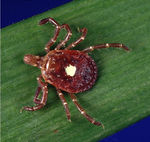Many of the hard tick species that infect animals in the UK are also present in other parts of Europe and the rest of the world information on these can be found here. There are many tick species that are important both in the effects of their ectoparasitism but also in their ability to transmit other infectious agents.
Ixodes spp.
Rhipicephalus spp.
Boophilus spp.
Amblyomma spp.
These ticks can be identified by;
- Large size
- Ornate scutums
- Eyes present
- Festoons
- Long palps
- Long legs
These ticks are distributed throughout tropical and sub-tropical areas of Africa as well as in temperate North America. The large mouth parts cause large painful bites and allow the females to ingest large volumes of blood which can lead to anaemia.
References
Amblyomma americanum
| Also known as: | Lone star tick |
This tick is found throughout central and eastern USA and is primarily important as a vector but has also been shown to reduce weight gain in cattle. It is responsible for transmission of Rickettsia rickettsii, Francisella tularensis, Q fever and Berrelia burgdorferi
Amblyomma variegatum
| Also known as: | Bont ticks
variegated or tropical bont tick |
Found throughout Africa, this tick is very important in its ability to transmit Cowdria ruminatium (heartwater) in Africa as well as viral Nairobi sheep disease and Q fever. There is distinct variation in the appearance of the males and female, the males are highly ornate with orange markings on the scutum compared to the brown female with a large pale patch on the scutum.
References
Hyalomma spp.
These are large ticks that are commonly found on the legs, udder, tail or perianal region of mammals. They are either two or three host ticks found in central Asia, southern Europe and North Africa. This is largely dependant Ticks of these species can identified by;
- Eyes present
- Long mouthparts
- Ventral plates around male anus
- Inornate
- Banded legs
Hyalomma anatolicum
| Also known as: | Bont-legged tick |
There are two subspecies known, H. anatolicum excavatum that is found in central Europe and Asia and H. anatolicum anatolicum which can be found throughout the rest of the range. These ticks cause tick toxicosis in Africa which is a sweating sickness seen in pigs and ruminants. This is accompanied by a profuse moist eczema and hyperaemia of the mucous membranes. This species can also be involved in the transmission of Theileria, Babesia spp. as well as Anaplasma marginale.
Hyalomma aegyptium
| Also known as: | Tortoise tick |
Infects tortoises in southern Europe and southwest Asia as well as lizards and occasionally dogs and horses. However this tick is being spread around the globe by the increasing pet trade in tortoises.
References
Pages in category "Hard Ticks - Overseas"
The following 5 pages are in this category, out of 5 total.
